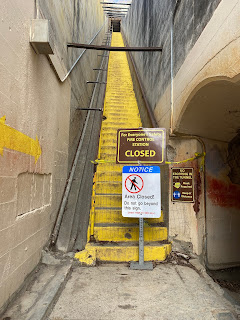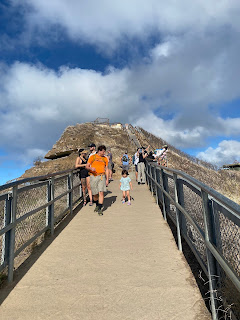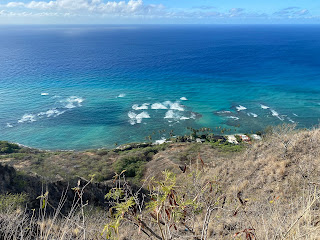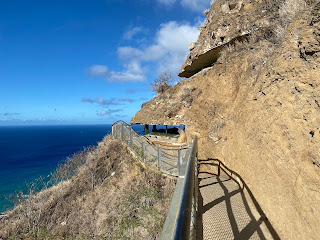Diamond Head Crater is a volcanic tuff cone on the Hawaiian Island of O'hau located in the City of Honolulu. The Diamond Head Crater is surrounded by several neighborhoods of Honolulu and offers a vista of the City from the top of the Summit Trail. Diamond Head Crater in the Hawaiian language is known as Lēʻahi.
This page is part of the Gribblenation O'ahu Highways page. All Gribblenation and Roadwaywiz media related to the highway system of O'ahu can be found at the link below:
https://www.gribblenation.org/p/gribblenation-oahu-highways-page.html
The formation of O'ahu began between 2.5-4 million years ago with volcanic eruptions from two shield volcanos emerging into a land mass from the Pacific Ocean. Over time the erosion of the two shield volcanos formed the basis of the modern Ko'olau and Wai'anae Mountain Ranges. Approximately 1.3 million years ago volcanic activity began in the Pacific Ocean at the southeastern end of the Ko'olau Range forming numerous cones. Lēʻahi is thought to have formed approximately 300,000 years ago from a single and brief eruption. Since erupting Lēʻahi began to erode into the state it is seen today.
In 1825 Lēʻahi was named "Diamond Hill" by British Sailors. The British mistook the volcanic calcite crystals on Lēʻahi for diamonds. Despite the lack of actual diamonds present on Lēʻahi the English name stuck and eventually became "Diamond Head" due to it being part of a headland. Diamond Head/Lēʻahi can be seen on 1856 J.H. Colton Map of the Hawaiian Islands on O'ahu.
Diamond Head can be seen in much greater detail on the 1881 Hawaiian Government Survey Map of O'ahu.
The importance of Fort Ruger diminished following World War II with much of the U.S. Army infrastructure inside Diamond Head becoming obsolete. Diamond Head Crater was declared a Hawaii State Monument in 1962 and became a National Natural Landmark in 1968. In modern times a few military facilities such remain active at Diamond Head Crater such as; the northern Kapahulu Tunnel, Battery 407, the Hawaii State Civil Defense Headquarters and a National Guard emergency operations center.
Part 2; hiking the Summit Trail to the top of Diamond Head Crater
From flying overhead Honolulu Diamond Head Crater is an obvious geographic feature. From the view below Diamond Head Crater can be seen towering east of Waikiki.
Diamond Head State Monument is accessible via Diamond Head Road along the eastern rim of the Crater. Traffic entering Diamond Head Crater must utilize the one lane Kahala Tunnel.
Traffic emerges from the Kahala Tunnel into the center of Diamond Crater where the trailhead for the Summit Trail can be found at the Diamond Head State Monument Visitor Center.
The Summit Trail is approximately 0.8 miles long but gains 560 feet in elevation. The starting portion of the Summit Trail is paved but comes a rock surface approaching the Diamond Head Crater rim.
The Summit Trail ascends through a series of rock switchbacks to an observation deck overlooking the center of Diamond Head Crater.
The Summit Trail emerges onto a second set of stairs which has 99 steps. The second set of stairs is advertised as a spur which can be used to access a second tunnel to the interior of the Fire Control Station. Unfortunately the spur trail to the Fire Control Station was closed when I was hiking the Summit Trail.
The Summit Trail approaches a metal staircase with a spur which overlooks Koko Crater east of Diamond Head Crater.
The metal staircase is 82 steps high approaching the Fire Control Station observation point. From the top of the 82 step metal staircase the 1917 Diamond Head Lighthouse can be below.
A final 54 step metal staircase ascends to the Fire Control Station observation point located at 761 feet above sea level. Looking westward a full view of Waikiki and downtown Honolulu can be observed.
The entirety of Diamond Head Crater can be seen from the Fire Control Station observation point facing east. Much of the Ko'olau Range and Koko Crater can also be observed facing eastward.







































































Comments